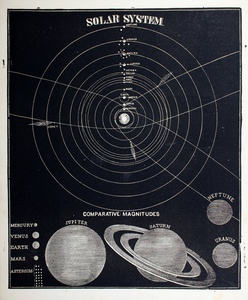| Method | Woodcut |
| Artist | Smith, Asa |
| Published | [By Asa Smith. Boston: Samuel F. Nichols, 43 Washington Street. 1866] |
| Dimensions | 255 x 210 mm |
| Notes |
A mid-nineteenth century astronomical chart, showing the Solar System and the comparative magnitude of planets in our solar system, from the 1866 edition of 'Smith's Illustrated Astronomy.' The orbits of the planets, as well as those of the first five bodies discovered in the asteroid belt, Vesta, Juno, Ceres, Pallas, and Astraea, are shown, as well as the elliptical paths of three comets. Pluto, which was only discovered and classified in 1930, is not shown. Below the orbits, the planets from Mercury to Neptune are shown in comparative size to each other, as are a group of the largest asteroids. Smith's Illustrated Astronomy, Designed for the Use of the Public or Common Schools in the United States was a general astronomical textbook, first published in 1848 but improved and reprinted a number of times. The author, Asa Smith, described himself as 'Former Principal of Public School No. 12, City of New York,' and the text of the book is designed as a number of lessons, positing questions that teachers could address to their pupils, along with the answers, both simplified and in depth. Smith's knowledge of his subject was enthusiastic but often flawed, perpetuating numerous mistruths or historical misunderstandings, particularly in regards to the historical appreciation of astronomy. The most egregious of these occurs in Smith's very first lesson, which denies any ancient knowledge of the spherical shape of our planet, instead telling students that ancient peoples believed the world to be a flat disc supported by an elephant or a turtle. While true for some Huron, Hindu, and Chinese mythemes, it in no way compares to the beliefs of the classical astronomers upon which Smith purports to rely. For later editions, the numerous illustrations and diagrams were updated and improved by Prof. Newcomb from Harvard's Astronomical Department, though the lessons themselves remained relatively unchanged. Asa Smith (fl.1848) was a New York based educator, best known for his very popular Illustrated Astronomy, a textbook created for use by American Public Schools. Condition: Minor time toning and foxing to edges of sheet. English text on verso. Framed in a thin black box frame. |
| Framing | framed |
| Price | £200.00 |
| Stock ID | 50422 |

